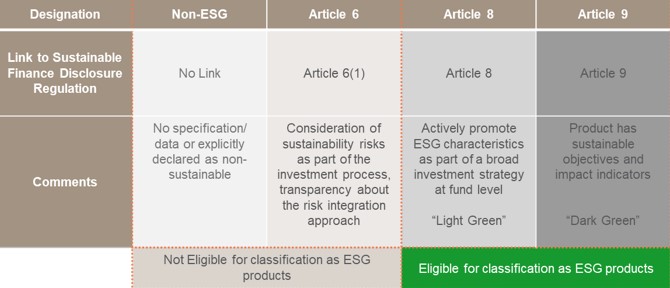Luxembourg – New York – On 26 January 2022, Vistra´s Country Managing Director Jervis Smith and Tomas Tobolka, Conducting Officer, presented to the LACC and AMCHAM network their insights on Opportunities & Challenges of ESG Regulatory Aspects
The discussion covered topics such as the EU Sustainable policies, the EU Sustainable Finance Action plan & SFDR, two of the key legislations as part of the European Commission’s plan, and what they considered the key 2022-2023 milestones.
Although there is a gap between the EU and the US in terms of ESG regulation, both continents share the same concern when it comes to climate-related risks, social impacts and governance performance.
In the US, pressure on ESG has largely come from Investors rather than Regulators
The private sector (institutional investors) is defining best practices around ESG by setting goals centred on ESG issues and adopting proxy voting policies that seek to promote the integration of ESG. The focus is no longer on financial performance only. Good ESG practices will become the new norm and ESG criteria embedded in companies operations and strategy.
The SEC is also undertaking a review of mandated climate-related and other ESG disclosure in public company filings, with recommendations expected before the end of this year.
In the EU, Regulation is the driving force
With the implementation of the EU Sustainable Finance Action Plan, the transition towards sustainable investing will be compelling. According to PwC, in the coming years, even the most ESG agnostic investors will have no choice but to consider sustainability in their investment process.
The main drivers for this trend : shareholders demand, based on a changing mindset toward responsible investing from younger generations; political and regulatory pressure; and protection of the firm’s reputation.
With the Sustainable Finance Disclosure Regulation (SFDR), which introduced new sustainability-related disclosure obligations for financial market participants marketing their products in the EU, and the EU taxonomy regulation, which is a directory for what constitutes sustainable activities, the EU has integrated sustainability considerations into the financial system and fostered sustainable investments’ growth.
Luxembourg, a leading domicile in ESG funds
The ALFI (Association of Luxembourg Fund Industry) reported that Luxembourg was highlighted as the leading domicile, with sustainable funds accounting for €371 billion by the end of 2020 and capturing 44% of total net flows made across all European domiciles in 2020.
In February 2021, Luxembourg’s triple-A rating by the credit rating agency Moody’s is in part an acknowledgement of its good ESG performance and a proof of the country´s commitment to sustainability.
In Luxembourg, SFDR became law on 10 March and impacted reporting requirements.
SFDR has a simple objective: avoid the ‘greenwashing’ of financial products and financial advice in the EU. SFDR aims to ensure that EU investors have the disclosures they need to make investment choices in line with their sustainability goals.
Under SFDR, financial market participants are required to disclose qualitative and quantitative information on their approach to ESG, including the management of sustainability risks – that may impact the value of their investments – and ‘principal adverse impacts’ – the potential negative impacts that their investments have on the environment and society.
What US managers or distributors will need to be aware of if they operate in the EU
At first glance, the SFDR creates significant additional administrative burden to fulfil the disclosure requirements. However, it has a more far reaching normative impact for asset managers/distributors and advisors operating in the EU.
Through the disclosure requirements SFDR essentially requires firms to make strategic decisions about their approach to sustainability. To communicate how a product impacts sustainability, managers/distributors will need to decide how to measure that impact. Does the distributor have a system in place to measure such impacts? If it does, how does it work? If not, should it develop a system? Which products are intended to minimize PAIs and which are not? Where PAIs are not considered, the SFDR requires a clear explanation for why this is the case.

The fund can then be allocated to each segment of relative compliance as described in the chart. This is, however, not without some challenges.
Indeed the approach taken to implement them has generated a lot of confusion and uncertainty. In many cases, reporting requirements were perceived as complex or incomplete, phased execution and moving deadlines have caused more confusion among the financial players.
With the first reporting period being 1 January 2022 to 31 December 2022, as a result, financial market participants and financial advisers, which consider PAI (Principal Adverse Impacts on sustainability matters), are urged to start collecting the relevant data as of the beginning of January 2022.
(The application of such single delegated act encompassing the RTS will be further postponed by a period of six months, resulting to 1 January 2023.)
It also seems like applying the taxonomy in practice presents challenges. While law enforcement and implementation is still in its infancy , there are clearly gaps between existing company internal requirements and requirements given through the taxonomy. a common understanding and knowledge of sustainable products and best practices will take time and an implementation of taxonomy taking into account the key milestones is a key requirement.
Small companies might experience certain limitations in disclosing taxonomy-relevant information due to lack of resources, expertise and incentives on providing data
Systems need to be adapted to be able to inspect clients and their value chains when anticipating the taxonomy incorporation. The truthfulness of sustainability related certificates is often only vaguely verified and needs to receive special attention.
The use of a third party might prove helpful in these instances. A further requirement for successful taxonomy use is the education of employees on sustainable business practices and taxonomy related requirements. Vistra is always happy to help.
If you would like to see the Zoom webinar watch here
In collaboration with
 |
 |
